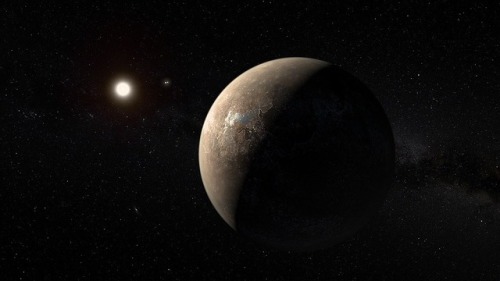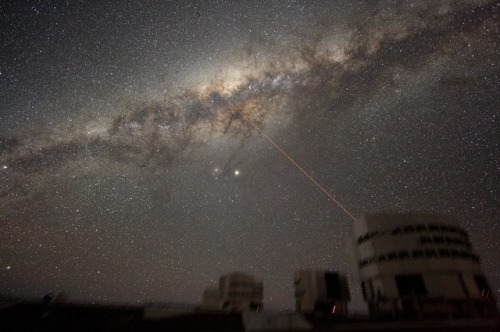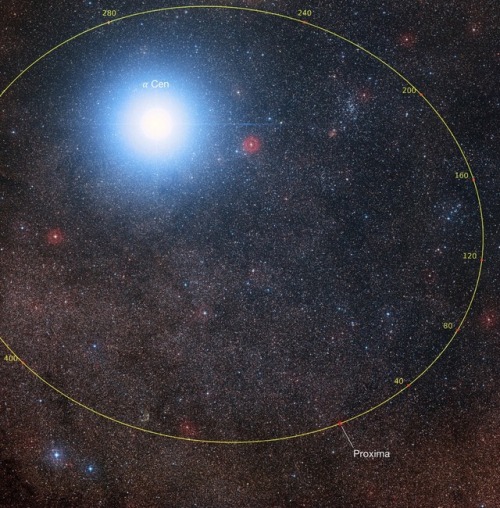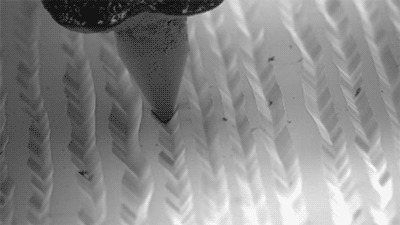Next Generation Spacesuit Like Second Skin

Next Generation Spacesuit like Second Skin
Scientists from MIT have designed a next-generation spacesuit that acts practically as a second skin, and could revolutionize the way future astronauts travel into space. (Photo : Jose-Luis Olivares/MIT)
Astronauts are used to climbing into conventional bulky, gas-pressurized spacesuits, but this new design could allow them to travel in style. Soon they may don a lightweight, skintight and stretchy garment lined with tiny, muscle-like coils. Essentially the new suit acts like a giant piece of shrink-wrap, in which the coils contract and tighten when plugged into a power supply, thereby creating a “second skin.”
“With conventional spacesuits, you’re essentially in a balloon of gas that’s providing you with the necessary one-third of an atmosphere [of pressure,] to keep you alive in the vacuum of space,” lead researcher Dava Newman, a professor of aeronautics and astronautics and engineering systems at MIT, said in astatement.
“We want to achieve that same pressurization, but through mechanical counterpressure - applying the pressure directly to the skin, thus avoiding the gas pressure altogether. We combine passive elastics with active materials. … Ultimately, the big advantage is mobility, and a very lightweight suit for planetary exploration.”
Newman, who has worked for the past decade on a design for the next-generation spacesuit, describes the new garment in detail in the journal IEEE/ASME: Transactions on Mechatronics.
The MIT BioSuit’s coils, which are a main feature of the outfit, are made from a shape-memory alloy (SMA). At a certain temperature, the material can “remember” and spring back to its engineered shape after being bent or misshapen.
Skintight suits are not a novel idea, but in the past scientists have always struggled with the question: how do you get in and out of a suit that is so tight? That’s where the SMAs come in, allowing the suit to contract only when heated, and subsequently stretched back to a looser shape when cooled.
Though the lightweight suit may not seem at first like it can withstand the harsh environment that is outer space, Newman and his colleagues are sure that the BioSuit would not only give astronauts much more freedom during planetary exploration, but it would also fully support these space explorers.
Newman and his team are not only working on how to keep the suit tight for long periods of time, but also believe their design could be applied to other attires, such as athletic wear or military uniforms.
“An integrated suit is exciting to think about to enhance human performance,” Newman added. “We’re trying to keep our astronauts alive, safe, and mobile, but these designs are not just for use in space.”
More Posts from Fillthevoid-with-space and Others



Life orbiting our closest star?
A planet has been found orbiting in the habitable zone of the closest star to earth, 4.2 light years away, named Proxima Centauri. The exoplanet, known as proxima b, has the mass of 1.27 earths but because of the shape of its orbit, the chances of it harbouring liquid water are fantastic. This vastly improves the chances that the planet sustains alien life.
What is an upcoming project/mission you're most excited for?
It is likely that I’ll be assigned a mission to the International Space Station (ISS) within the next few years. We’ve had a continuous presence on the Space Station for 17 years now, along with our international partners (Russian Space Agency, European Space Agency, Japanese Space Agency, and Canadian Space Agency). Missions on the ISS typically last 6 months. I’m incredibly excited to contribute to the impressive array of scientific experiments that we are conducting every day on ISS (I am a scientist after all!), and very much look forward to the potential of going for a spacewalk and gaining that perspective of gazing down on the fragile blue ball that is our home from above. Beyond that, being part of test missions on the Orion spacecraft (currently under construction at NASA!) would be an extraordinary opportunity. The current NASA plan is to send astronauts in Orion in a mission that will go 40,000 miles beyond the Moon in the early 2020s, reaching a distance further than that ever travelled by humans. I’d certainly be game for that!






Sharpest View of the Andromeda Galaxy, Ever.
The NASA/ESA Hubble Space Telescope has captured the sharpest and biggest image ever taken of the Andromeda galaxy — a whopping 69,536 x 22,230 pixels. The enormous image is the biggest Hubble image ever released and shows over 100 million stars and thousands of star clusters embedded in a section of the galaxy’s pancake-shaped disc stretching across over 40,000 light-years.
Use the ZOOM TOOL to view in full detail.
(WARNING: May cause existential crisis)

I’ve gotten some feedback that episodes can be too technical. Unfortunately, that feedback came too late to save you from this week’s episode, which requires me to summarize the electromagnetic spectrum, radio astronomy, a concept called interferometry, and government regulations to talk about the topic that originally started me on this path: radio quiet zones. Please, bear with me! Pardon my mess! It was all very interesting stuff, I couldn’t resist digging into it.
Below the cut are my sources, music credits, a vocab list, a timeline of the astronomers I mention, and the transcript of this episode. I’ve bolded those sources I mention in the podcast, including the podcast that started me on this topic: The Adventure Zone! Please let me know what you think I should research next by messaging me here, tweeting at me at @HDandtheVoid, or asking me to my face if you know me. I’d love it if you would subscribe on iTunes, rate my humble little podcast and maybe review it, and tell friends if you think they’d like to hear it!
(My thoughts on the next episode are SOFIA, which you need to listen to find out what it stands for, or the pilot Chuck Yaeger. The next episode will go up February 26th.)
Glossary
aperture synthesis - the process of collecting electromagnetic radiation from a variety of separate, small telescopes and then combining this data to recreate the image at a higher resolution than would be possible with a single telescope.
frequency - the number of times a wave oscillates up and down per second.
hertz - the number of times an electromagnetic wave cycles per second. One cycle per second is 1 hertz.
interferometry - a group of techniques to extract information from superimposing electromagnetic waves to create interference. In radio astronomy, this is done by using a wide spread of receivers to look at the same distant object, then bringing that data together with a correlator that can create a larger, clearer picture than an individual radio telescope alone could.
radiation - energy that travels and spreads out as it goes.
Script/Transcript
Timeline
Joseph-Louis Lagrange, French (1736-1813)
Armand-Hippolyte-Louis Fizeau, French (1819-1896)
Edward W. Morley, American (1838-1923)
Albert A. Michelson, American (1852-1931)
Sir Martin Ryle, British (1918-1984)
Bernard Yarnton Mills, Australian (1920-2011)
Derek Vonberg, British (1922-2015)
Antony Hewish, British (1924- )
Sources
Electromagnetic spectrum via NASA
Observatories across the EM spectrum via NASA
Fermi satellite via NASA
The Neil Gehrels Swift Observatory via NASA
NuSTAR via Caltech
NuSTAR via NASA
Chandra X-Ray Observatory via Harvard
The Galaxy Evolution Explorer (GALEX) via Caltech
Kepler satellite via NASA
Hubble Space Telescope via NASA
Spitzer satellite via Caltech
Stratospheric Observatory for Infrared Astronomy (SOFIA)
Planck satellite via ESA
Spekt-R Radioastron from Russia
High Energy Stereoscopic System (HESS)
W. M. Keck Observatory on Mauna Kea
South Africa Large Telescope (SALT) in Namibia
The Combined Array for Research in Millimeter-Wave Astronomy (CARMA) via Caltech
CARMA public page (decommissioned)
Very Large Array (VLA) via NRAO
Space radio telescope (1997) via NRAO
Highly Advanced Laboratory for Communications and Astronomy (HALCA) via NASA
A timeline of the history of radio interferometry via University of Groningen (Netherlands)
Interferometers via the LIGO Laboratory
Michelson-Morley Experiment via University of Virginia
Astronomical Interferometry via Magdalena Ridge Observatory
Interferometry via XKCD
How Radio Works via How Stuff Works
Radio Spectrum Allocation via the Federal Communications Commission
Interferometry via the European Space Observatory
National Radio Quiet Zone via National Radio Astronomy Observatory
“minimize possible harmful interference to the National Radio Astronomy Observatory (NRAO) in Green Bank, WV and the radio receiving facilities for the United States Navy in Sugar Grove, WV.”
National Radio Quiet Zone via CNN
“Tucked in the Allegheny Mountains, researchers are listening to exploding galaxies at the edge of the universe – a signal that is so faint, it’s about a billionth of a billionth of a millionth of a watt.”
The Quiet Zone: Where mobile phones are banned via BBC News (May 2015)
Enter The Quiet Zone: Where Cell Service, Wi-Fi Are Banned via NPR (Oct 2013)
Green Bank Observatory in West Virginia, USA
Karen O’Neil: “The types of energies we look at are less than the energy of a single snowflake falling on the Earth.”
Characteristics of radio quiet zones via International Telecommunication Union (Sept 2012)
“transmissions below 15 GHz are restricted within a certain radius around the Arecibo Observatory, located in Puerto Rico. Since no observations are carried out, nor are any expected to be carried out above that frequency in the future, no restrictions are needed on higher frequency transmissions. The reverse is not necessarily true, however. For example, some restrictions may be imposed on transmissions below 30 GHz in the neighbourhood of the large international ALMA observatory even though it is not expected to ever observe below that frequency, due to its susceptibility to interference at these lower frequencies in the signal path.”
“It is important to emphasize that a RQZ does not imply a complete absence of radio transmissions. The existence of, and coexistence with, a range of man-made devices will always be necessary. A RQZ may include options for notification of other users and for negotiation in mitigating interference. On the other hand, a RQZ does not consist entirely of mitigating techniques implemented by the radio astronomy facility; some level of control on externally-generated interference is intrinsic to a RQZ.
A RQZ is therefore a buffer zone that allows for the implementation of mechanisms to protect radio astronomy observations at a facility within the zone from detrimental radio frequency interference, through effective mitigation strategies and regulation of radio frequency transmitters.”
ALMA Observatory website
The Scientific Committee on Frequency Allocations for Radio Astronomy (IUCAF) website
Google Map of worldwide radio quiet zones (Aug 2016)
ITU-R Recommendations of Particular Importance to Radio Astronomy by A. Richard Thompson
“the necessity of maintaining the shielded zone of the Moon as an area of great potential for observations by the radio astronomy service and by passive space research, and consequently of maintaining it as free as possible from transmissions.”
The Adventure Zone: Amnesty setup episode via Maximum Fun
Intro Music: ‘Better Times Will Come’ by No Luck Club off their album Prosperity
Filler Music: ‘Junkyard Chandelier’ by Radical Face aka Ben Cooper, who primarily releases music as Radical Face but also has at least three other bands or band names he’s working with/has released music as.
Outro Music: ‘Fields of Russia’ by Mutefish off their album On Draught

What is a Magnetar?
A magnetar is a type of neutron star with an extremely powerful magnetic field, the decay of which powers the emission of high-energy electromagnetic radiation, particularly X-rays and gamma rays.1
History
On March 5, 1979, several months after dropping probes into the toxic atmosphere of Venus, two Soviet spacecraft, Venera 11 and 12, were drifting through the inner solar system on an elliptical orbit. It had been an uneventful cruise. The radiation readings on board both probes hovered around a nominal 100 counts per second. But at 10:51AM EST, a pulse of gamma radiation hit them. Within a fraction of a millisecond, the radiation level shot above 200,000 counts per second and quickly went off scale.
Eleven seconds later gamma rays swamped the NASA space probe Helios 2, also orbiting the sun. A plane wave front of high-energy radiation was evidently sweeping through the solar system. It soon reached Venus and saturated the Pioneer Venus Orbiter’s detector. Within seconds the gamma rays reached Earth. They flooded detectors on three U.S. Department of Defense Vela satellites, the Soviet Prognoz 7 satellite, and the Einstein Observatory. Finally, on its way out of the solar system, the wave also blitzed the International Sun-Earth Explorer.
The pulse of highly energetic, or “hard,” gamma rays was 100 times as intense as any previous burst of gamma rays detected from beyond the solar system, and it lasted just two tenths of a second. At the time, nobody noticed; life continued calmly beneath our planet’s protective atmosphere. Fortunately, all 10 spacecraft survived the trauma without permanent damage. The hard pulse was followed by a fainter glow of lower-energy, or “soft,” gamma rays, as well as x-rays, which steadily faded over the subsequent three minutes. As it faded away, the signal oscillated gently, with a period of eight seconds. Fourteen and a half hours later, at 1:17AM on March 6, another, fainter burst of x-rays came from the same spot on the sky. Over the ensuing four years, Evgeny P. Mazets of the Ioffe Institute in St. Petersburg, Russia, and his collaborators detected 16 bursts coming from the same direction. They varied in intensity, but all were fainter and shorter than the March 5 burst.
Astronomers had never seen anything like this. For want of a better idea, they initially listed these bursts in catalogues alongside the better-known gamma-ray bursts (GRBs), even though they clearly differed in several ways. In the mid-1980s Kevin C. Hurley of the University of California at Berkeley realized that similar outbursts were coming from two other areas of the sky. Evidently these sources were all repeating unlike GRBs, which are one-shot events [see “The Brightest Explosions in the Universe,” by Neil Gehrels, Luigi Piro and Peter J. T. Leonard; Scientific American, December 2002]. At a July 1986 meeting in Toulouse, France, astronomers agreed on the approximate locations of the three sources and dubbed them “soft gamma repeaters” (SGRs). The alphabet soup of astronomy had gained a new ingredient.
Another seven years passed before two of us (Duncan and Thompson) devised an explanation for these strange objects, and only in 1998 did one of us (Kouveliotou) and her team find remains of a star that exploded 5,000 years ago. Unless this overlap was pure coincidence, it put the source 1,000 times as far away as theorists had thought—and thus made it a million times brighter than the Eddington limit. In 0.2 second the March 1979 event released as much energy as the sun radiates in roughly 10,000 years, and it concentrated that energy in gamma rays rather than spreading it across the electromagnetic spectrum.2
About 26 magnetars are known (see here).
1 http://en.wikipedia.org/wiki/Magnetar
2 http://solomon.as.utexas.edu/~duncan/sciam.pdf

sun depicted as a divinity petroglyph on the plateau Yagour (High Atlas mountains), Morocco.. 6000 to 8000 BC
why is there star
gas cloud get squished (gravitational collapse) then sometimes smaller elements can squish together to make bigger elements (nuclear fusion) and this continues as long as the smolest elements (hydrogen and helium) are in the core
-
 billvicious liked this · 1 year ago
billvicious liked this · 1 year ago -
 justanoldfashiontumblog liked this · 2 years ago
justanoldfashiontumblog liked this · 2 years ago -
 riptide-rabbitholes reblogged this · 3 years ago
riptide-rabbitholes reblogged this · 3 years ago -
 mexicampbells liked this · 3 years ago
mexicampbells liked this · 3 years ago -
 littleplasticspaceship reblogged this · 4 years ago
littleplasticspaceship reblogged this · 4 years ago -
 bisexualbard reblogged this · 4 years ago
bisexualbard reblogged this · 4 years ago -
 addamatic reblogged this · 4 years ago
addamatic reblogged this · 4 years ago -
 gwydionmisha reblogged this · 4 years ago
gwydionmisha reblogged this · 4 years ago -
 gwydionmisha liked this · 4 years ago
gwydionmisha liked this · 4 years ago -
 firecology liked this · 4 years ago
firecology liked this · 4 years ago -
 cyberpilate liked this · 4 years ago
cyberpilate liked this · 4 years ago -
 father-tony liked this · 4 years ago
father-tony liked this · 4 years ago -
 bookwormfan1495 reblogged this · 4 years ago
bookwormfan1495 reblogged this · 4 years ago -
 vironicadart reblogged this · 4 years ago
vironicadart reblogged this · 4 years ago -
 vironicadart liked this · 4 years ago
vironicadart liked this · 4 years ago -
 astrotracksuitbattalion liked this · 4 years ago
astrotracksuitbattalion liked this · 4 years ago -
 disasterhimbo liked this · 4 years ago
disasterhimbo liked this · 4 years ago -
 abby-gaytes liked this · 4 years ago
abby-gaytes liked this · 4 years ago -
 liveanothersol reblogged this · 4 years ago
liveanothersol reblogged this · 4 years ago -
 spockvarietyhour reblogged this · 4 years ago
spockvarietyhour reblogged this · 4 years ago -
 spockvarietyhour liked this · 4 years ago
spockvarietyhour liked this · 4 years ago -
 notlily2 liked this · 4 years ago
notlily2 liked this · 4 years ago -
 piciu75 liked this · 4 years ago
piciu75 liked this · 4 years ago -
 aibari reblogged this · 4 years ago
aibari reblogged this · 4 years ago -
 pairofsmittens reblogged this · 4 years ago
pairofsmittens reblogged this · 4 years ago -
 pairofsmittens liked this · 4 years ago
pairofsmittens liked this · 4 years ago -
 skinsocks liked this · 4 years ago
skinsocks liked this · 4 years ago -
 emily84 reblogged this · 4 years ago
emily84 reblogged this · 4 years ago -
 shimozu liked this · 4 years ago
shimozu liked this · 4 years ago -
 anbaric-lights reblogged this · 4 years ago
anbaric-lights reblogged this · 4 years ago -
 cephalopod-demigod liked this · 4 years ago
cephalopod-demigod liked this · 4 years ago -
 caterjunes reblogged this · 4 years ago
caterjunes reblogged this · 4 years ago -
 mossfields liked this · 4 years ago
mossfields liked this · 4 years ago -
 theirrationalfan liked this · 4 years ago
theirrationalfan liked this · 4 years ago -
 schocolateymenta liked this · 5 years ago
schocolateymenta liked this · 5 years ago -
 onesingledreamer reblogged this · 5 years ago
onesingledreamer reblogged this · 5 years ago -
 heroofashesnot liked this · 5 years ago
heroofashesnot liked this · 5 years ago -
 iashido reblogged this · 5 years ago
iashido reblogged this · 5 years ago -
 7th-sound reblogged this · 5 years ago
7th-sound reblogged this · 5 years ago -
 areite liked this · 6 years ago
areite liked this · 6 years ago -
 skittermouse reblogged this · 6 years ago
skittermouse reblogged this · 6 years ago
A podcast project to fill the space in my heart and my time that used to be filled with academic research. In 2018, that space gets filled with... MORE SPACE! Cheerfully researched, painstakingly edited, informal as hell, definitely worth everyone's time.
243 posts
























